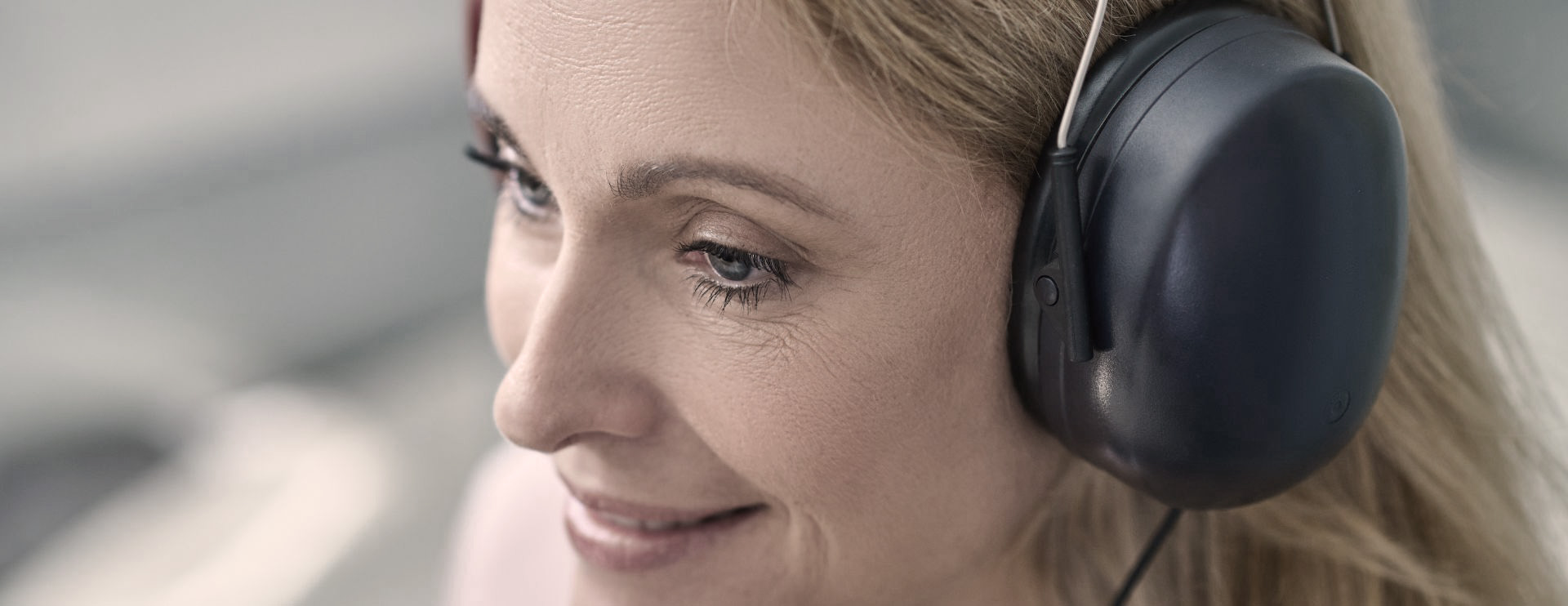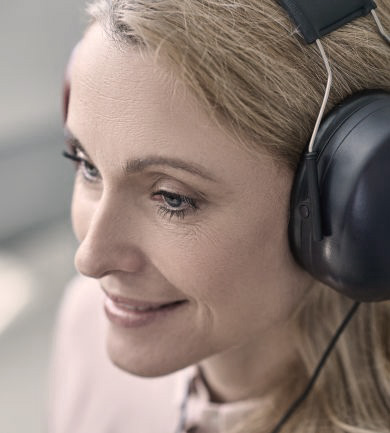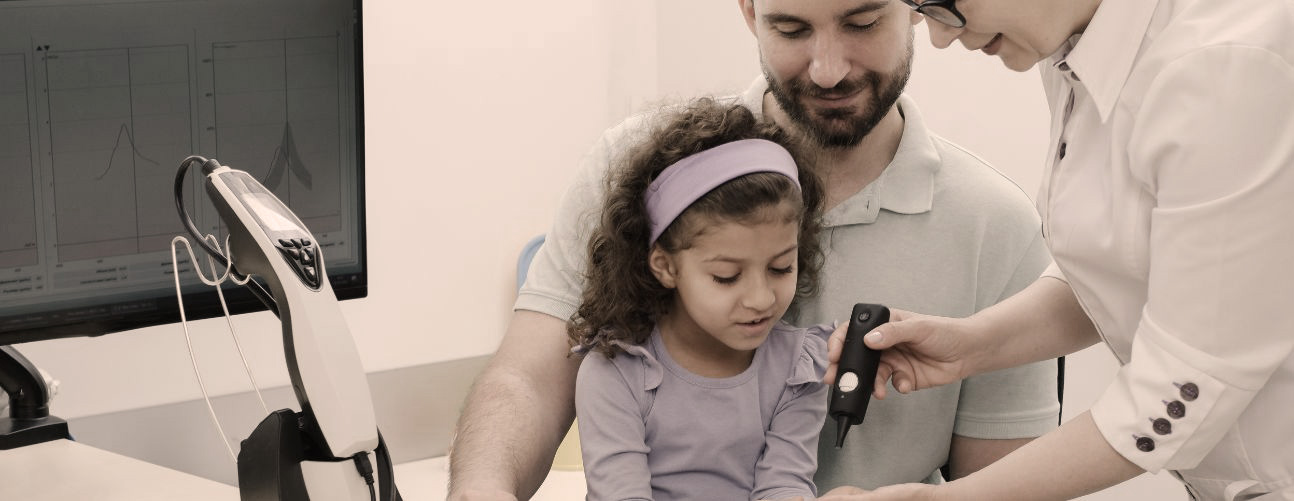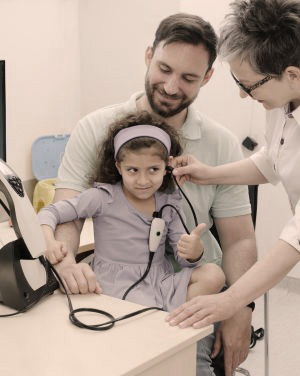

Assessments
The diagnosis of hearing problems, dizziness or balance disorders is based on a thorough medical history, a complete clinical examination and assessments of the auditory system or balance system. These investigations are carefully selected on the basis of the patient’s functional disorders, using decision trees drawn up by scientific societies.
Oto Neuro Monaco has an outstanding technical platform. All examinations are performed by highly qualified personnel.
Deafness, tinnitus, hyperacusis
Audiometry
The term audiometry encompasses a range of techniques used to assess a patient’s hearing. A distinction is made between subjective audiometric tests, in which the patient provides a response to an auditory stimulus, and objective audiometric tests, in which these responses are collected by a measuring device.
Tympanometry
Tympanometry studies certain physical characteristics of the middle and inner ear (their ability to absorb some of the sound energy that reaches the eardrum and ossicular chain, and the protective reflexes of the inner ear against loud sounds). It is of great interest for the evaluation of many diseases affecting hearing or balance.
Auditory Brainstem Response
Auditory Brainstem Response (ABR) is one of the objective hearing tests, in which responses to sound stimuli are collected by a measuring device. This test records the electrical activity that propagates along the auditory pathways, from the auditory nerve to the auditory areas of the brain, in response to auditory stimuli. These signals are collected using electrodes placed on the forehead and mastoids, and sometimes on the scalp.
Otoacoustic Emissions
The Otoacoustic Emissions (OAE) test is one of the objective hearing tests in which responses to sound stimuli are collected by a measuring device. This test shows the functioning of the outer hair cells of the cochlea (OHCs), which amplify sound waves reaching the inner ear. The signals are collected with a microphone placed in the patient’s ear canal.
Electrochleography
Electrochleography measures the electrical responses of sensory cells in the inner ear in response to a sound stimulus. In particular, it measures the electrical activity of the inner hair cells of the cochlea, which are responsible for translating sound signals into electrical signals, and that of the auditory nerve.


Vertigo, balance disorders :
Videonystagmography
Videonystagmography is an examination that analyses nystagmus, using a video camera coupled with a computer to analyse eye movements.
Nystagmus is a movement of the eyes following a movement of the head or body, in the plane of this movement (vertical, horizontal, rotational or torsional), with a slow deviation of the eyes at the same speed and in the opposite direction to that of the head, in order to maintain stable vision during the movement, and a rapid return saccade in the opposite direction when maximum eye deviation is reached.
Nystagmus is a normal stabilisation process of gaze during movement. In the absence of movement, nystagmus is always pathological. Nystagmus can be found in the case of damage to the balance sensors of the inner ear (semicircular canals, otolithic sensors), the vestibular nerve or the central nervous system (particularly the brainstem).
Video nystagmography is the cornerstone of the study of the balance system.
VHIT
The Video Head Impulse Test is an examination of the movement sensors of the inner ear (semicircular canals) that uses a video camera coupled with a computer to analyse compensatory eye movements aimed at stabilising vision during very rapid head movements (impulses) caused by the examiner. It is the only vestibular test that allows the three semicircular canals of each ear to be examined individually.
Otolithic evoked potentials
Otolithic evoked potentials are used to assess the function of the saccular and utricular sensors of the vestibule, the part of the inner ear dedicated to analysing the acceleration of the head in the vertical and horizontal planes, thus in relation to the earth’s gravity. It is thanks to the information they provide to the balance system that we can determine with great accuracy the position of our body or objects in relation to the vertical (direction of the gravity vector).
Video-oculography
Video-oculography analyses eye movements using high-performance video cameras that record voluntary or reflex eye movements, combined with a computer that analyses the characteristics of these movements. This examination is very useful for the medical diagnosis of many diseases that affect the nervous system and have consequences on vision, balance and cognitive abilities.
Stabilometry
Maintaining an upright posture, both in static conditions and during movement, requires information from the eyesight, inner ear and somesthetic sensors in the neck and lower limbs. This information is processed by our central nervous system, which constantly sends orders to our effector system (postural muscles, eye muscles) to stabilise our body and avoid falling.
The analysis of the postural system is the domain of posturography or stabilometry. In our centre it is performed on a state-of-the-art platform, the Motion VR from VIRTUALIS. The device acquires the patient’s posture and analyses it in a series of everyday conditions, if necessary simulated in Virtual Reality.
Orthoptic and neurovisual assessment
The visual system occupies an important place in the brain, brainstem and cerebellum. It is strongly involved in many cognitive tasks, such as language learning. Vision is also an essential part of the balance system, together with information from the inner ear and somesthesia.
Given its importance for the central nervous system, the functioning of the visual system can be impaired in a large number of neurological conditions, ranging from simple concussion to tumours or strokes, as well as inflammatory diseases such as multiple sclerosis.
Therefore, whether it is a child with a severe learning disability (dyslexia, dysgraphia, dysorthographia), an adult with a reading disability, or both with a balance problem caused by exposure to certain visual situations, it is necessary to look for an orthoptic problem (binocular vision problems, strabismus, oculomotor paralysis) or a neurovisual disorder.
